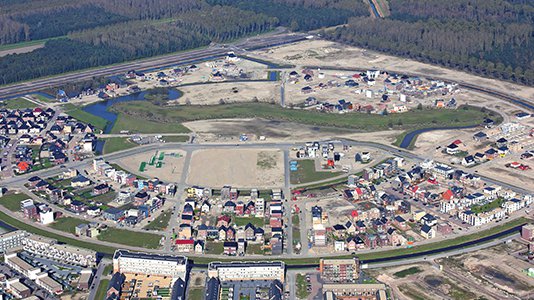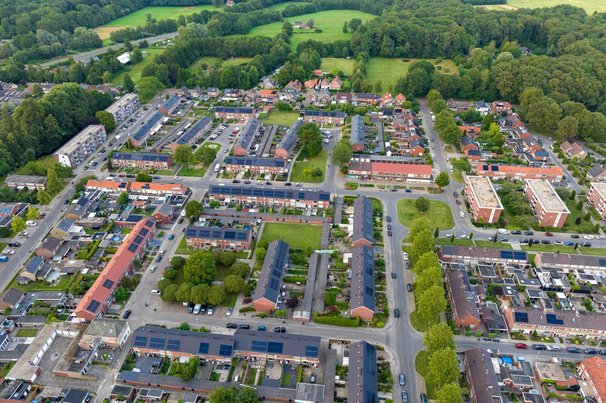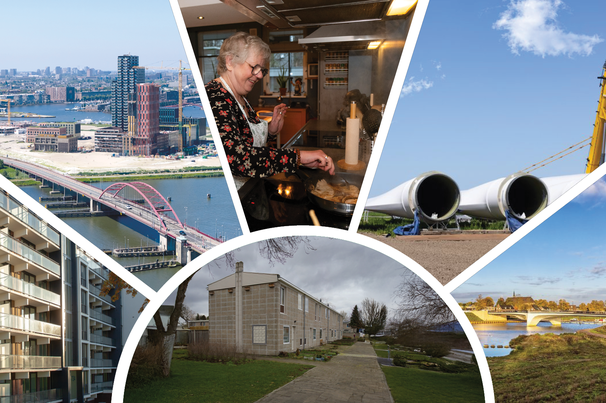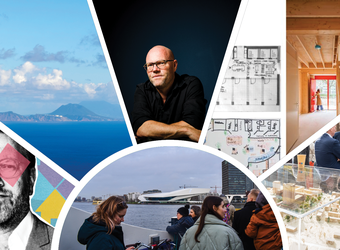Nieuws New Towns: anders dan organisch gegroeide steden zijn ze het resultaat van tijdgebonden opvattingen over welvaart, welzijn, planning en ontwerp. Daarmee zijn ze ook een spiegel van de maatschappij – in politiek, cultureel en sociaal opzicht. In korte tijd uit de grond gestampt, fungeren ze ten eerste als dragers van een moderne levensstijl. In hoeverre slagen ze erin die rol te vervullen? En hoe vergaat het new towns in een veranderende samenleving? In de voor iedereen toegankelijke lezingenreeks 'The New Town: from Welfare City to Neoliberal Utopia' worden deze vragen nader geadresseerd. Een inleiding.
Klik hier voor de lezingenreeks.
Foto: Homerus kwartier Almere, erfenis New Town denken
On 21 April, Michelle Provoost (director INTI International New Town Institute) en Wouter Vanstiphout (professor Design as Politics) kicked off the lecture series at the TU Delft Faculty of Architecture. New town building is often associated with the post-war period, the 50’s and 60’s of the 20th century, when urban growth worldwide was often accommodated by creating new sizeable autonomous urban environments from scratch. But, as Vanstiphout points out, there are older examples of how entire urban environments are created purposefully (and top-down). As the planning structure of Washington D.C. and other capital cities clearly show, new states tend to plan and build new capitals as material symbols of state ideals. ‘Washington’s layout is the layout of US democracy.’
Garden cities
Governments are however not the only forces behind new town planning and development. Social movements, looking for alternatives for institutional urban planning, are responsible for some of the most innovative planning developments in the 20th century. Prime example is the garden city model by Ebenezer Howard (1850-1928). Combining the qualities of urban and rural communities he designed a new type of residential area, away from the disadvantages and drawbacks of industrial society and based on specific notions of social organisation, such as self-sufficiency. Vanstiphout: ‘From the twenties and thirties onward, the garden city model was appropriated by governments of all political creeds at home and abroad and thus became a basis for shaping the post-war welfare state.’ The idea that towns, cities and even an entire country, can be spatially, economically and socially restructured and reorganised by building up society from the household upwards, became a central notion in spatial and housing development. In the Netherlands, new towns, connected by new infrastructure – from telephone lines to motorways – and with all the functions and amenities that go with the welfare state clearly designated, were for several decades destined to help shape and epitomise modern society, populated by more or less egalitarian communities, ‘the whole functioning as a single state-driven machine.’
Public to private
In a consumer society, the next step in the development of the welfare state, freedom of choice becomes the cardinal means of emancipation. A state-planned new town such as Milton Keynes in the UK is meant to provide this freedom of choice by setting a high standard of living, Vanstiphout explains. ‘At a certain point, however, delivering the goods becomes too expensive and market players step in or are invited to do so.’ This changes the perspective. Public services are increasingly privatised. The use and programming of urban space itself becomes driven by private rather than public interests. When the state then starts to act on the basis of private interests and formidable real estate developments are rolled out on the basis of public-private partnerships with the main purpose of making money, (former) public interests become too dependent on the economic climate, as recent economic and real estate crises demonstrate. ‘As a result, the original notion that people bring in their own means and build their own affordable homes now resurfaces in town planning. Instead of being employed by big institutional clients, the architect may find himself in the strange situation that he has to work for real people.’
New towns exported and in decline
Garden city-concepts, easy to explain and export, were transplanted and elaborated on across Western Europe as well as other parts of the world in the course of the 20th century. Provoost stresses the role new towns have played as political instruments. ‘During the Cold War, western governments introduced new town concepts in developing countries in order to establish democratic ideals and western values.’ A quality that all new towns, from ancient Mylete in Greece to futuristic Songdo in South Korea, have in common, says Provoost, ‘is that they their creators are trying to improve on existing cities.’
In recent decades, due to lack of demographic and economic growth, some new towns developed into urban environments that are opposite to their idealistic roots. In the Netherlands, France, the UK and other countries they became the homes of the underprivileged, with relatively high crime, poverty and unemployment rates. Provoost: ‘This seems to apply to the new towns that failed to evolve into middle class environments in a flourishing consumer society.’ Instead they underwent a form of “ghettoization”, adding to urban social segregation, by housing people who could not afford to move elsewhere. These residents became increasingly dissatisfied with their surroundings. In recent years many of these urban areas in decline were consequently either torn down or revitalised.
The second generation
As a planning concept for progressive urban development the new town has become increasingly unpopular in Western Europe. In other parts of the world, however, such as South-East Asia, a second generation of new towns has emerged in accordance with economic and demographic growth. These cities, generally named market cities or neoliberal cities, are substantially different from the older European welfare cities in that they are principally geared to the well-to-do. Interestingly these new towns developments all have basic characteristics in common, a result of their being designed on the same principles. Provoost: ‘Their urban planning is overall car-based and they are often built around a service-oriented high-rise city centre.’
When equipped with state of the art, ‘smart’ technology they are positioned as smart cities, again representing contemporary notions of what a modern city should look like and how it should function. ‘As regards the urban fabric, however, these cities are actually old-fashioned, reproducing 20th-century modernist planning and design concepts’, says Provoost. And in terms of urban identity, they seem to replicate and repeat existing cityscapes elsewhere rather than incorporate local culture. This can be explained perhaps by the extent to which these new towns are privately developed using more or less generic designs. As Provoost shows, some second generation new towns, Alphaville in Brazil being one of the first in line, are completely privately financed and developed, offering the urban wealthy gated communities, plenty of space and all the amenities in place at a safe distance from metropolitan life and its downsides. With companies like Cisco, Siemens and Ikea investing in large scale urban development, a new type of commercial new town is on the rise. Whether this is a growing trend, how they affect or relate to society and what architects and urban designers might contribute to second generation new town development appear to be challenging research questions.
Lees verder:
Cover: ‘2015.05.03_New Towns Then and Now_C’






